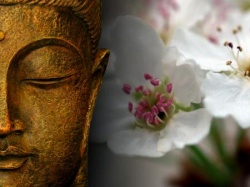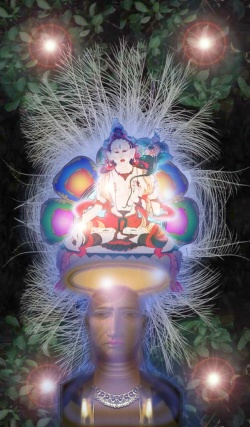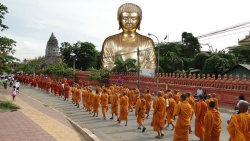Difference between revisions of "Oddiyana"
m (Text replacement - "birthplace " to "birthplace ") |
|||
| Line 14: | Line 14: | ||
::* {{Wiki|Swāt Valley}} region of present-day [[Khyber Pakhtunkhwa]], {{Wiki|Pakistan}}, close to the {{Wiki|Afghanistan}}-{{Wiki|Pakistan}} border. | ::* {{Wiki|Swāt Valley}} region of present-day [[Khyber Pakhtunkhwa]], {{Wiki|Pakistan}}, close to the {{Wiki|Afghanistan}}-{{Wiki|Pakistan}} border. | ||
| − | Most [[scholars]] {{Wiki|conventionally}} place it here. {{Wiki|Swat}} is [[thought]] to be the probable | + | Most [[scholars]] {{Wiki|conventionally}} place it here. {{Wiki|Swat}} is [[thought]] to be the probable birthplace of [[Vajrayana Buddhism]]. |
::* [[Orissa]] locality of Eastern [[India]], through a case founded upon "{{Wiki|literary}}, {{Wiki|archeological}} and iconographic {{Wiki|evidence}}, according to [[Keown]], et al. (2003: p. 203). | ::* [[Orissa]] locality of Eastern [[India]], through a case founded upon "{{Wiki|literary}}, {{Wiki|archeological}} and iconographic {{Wiki|evidence}}, according to [[Keown]], et al. (2003: p. 203). | ||
Revision as of 03:49, 8 February 2016
Click here to see other articles relating to word Oddiyana
Oḍḍiyāna; (Skt. Oḍḍiyāna; Tib. ཨུ་རྒྱན, Orgyen; Wylie u rgyan (Pashto: اوډيانه; Oriya: ଓଡ଼ିଆଣ) a small country in early medieval India, ascribed importance in the development and dissemination of Vajrayana (Tantric) Buddhism.
The physical location of Oḍḍiyāna is disputed and open to conjecture.
Possible locations that have been identified are:
- Swāt Valley region of present-day Khyber Pakhtunkhwa, Pakistan, close to the Afghanistan-Pakistan border.
Most scholars conventionally place it here. Swat is thought to be the probable birthplace of Vajrayana Buddhism.
Scholars championing this location contend that the name Oḍḍiyāna derives from the Dravidian Oṭṭiyan, denoting a native or indigenous person of Oḍra (Orissa) or from Oṭṭiyam, Telugu for Oḍra.
Oḍḍiyāna is also the Middle Indic form of Udyāna, meaning "garden," the name by which Hsüan Tsang knew the region around Orissa.
- In later Tibetan traditions, Oḍḍiyāna is either conflated or identified with Shambhala, a land inhabited by dakini and inaccessible to or by, ordinary mortals being a beyul or 'hidden land'.
The matter of the conflation of Indrabhuti and at least one evocation of the historicity of a particular personage by that name is intimately connected with the location of 'Oddiyana'
(the locality denoted by the term 'Oddiyana' whether in each case cited is Swat Valley or Orissa or some other location is glossed with a suite of orthographic representations and near homophones which require further case-by-case examination and exploration), Orissa and the cult of Jagannath and a number of texts that inform the matter such as; the
as Donaldson (2001: p. 11) frames an overview of some of the debate and then ventures further salience:
- In his argument, P. C. Bagchi states that there are two distinct series of names in Tibetan: (1) O-rgyān, U-rgyān, O-ḍi-yā-na, and (2) O-ḍi-vi-śā, with the first series connected with Indrabhūti, i.e., Oḍiyăna and Uḍḍiyāna, while the second series falls back on Oḍi and Oḍiviśa, i.e., Uḍra (Orissa) and has nothing to do with Indrabhūti.
N.K. Sahu objects, however, and points out that these two sets of names are seldom distinguished in Buddhist Tantra literature, and opines that the words Oḍa, Oḍra, Uḍra, Oḍiviśa and Oḍiyāna are all used as variants of Uḍḍiyāna.
In the Sādhanamālā, he further points out, Uḍḍiyāna is also spelt as Oḍrayāna while in the Kālikā Purāṇa, as indicated earlier, it is spelt either Uḍḍiyāna or Oḍra.
There is also evidence, Sahu continues, that Indrabhūti is the king of Orissa rather than of the Swāt valley.
The Caturāsiti-siddha-Pravṛtti, for example, mentions him as the king of Oḍiviśa while Cordier, in his Bṣtān-ḥgyur catalogue, gives sufficient indications of his being the king of Orissa.
Also, in his famous work Jñānasiddhi, king Indrabhūti opens it with an invocation to Lord Jagannātha, a deity intimately associated with Orissa and with no other area of India.
Orgyan or Orgyen
In the 'Seven Line Prayer' (of Padmasambhava) revealed in Jigme Lingpa's terma of the Ngöndro of the Longchen Nyingthig and throughout the Longchen Nyingtig Ngondro, Oddiyana is rendered in the form Tibetan: ཨོ་རྒྱན, Wylie: o rgyan.
Tibetan Buddhism
In Tibetan Buddhist literature, Oḍḍiyāna is described as being ruled by several kings each of whom were named Indrabhūti.
Oddiyana was a city said to be a seat of Vajrayana practice situated in the geographical area of North-Western Khyber Pakhtunkhwa, Pakistan.
A number of Vajrayana and Tantric practitioners are said to have stayed and practiced there.
In Mahayana folklore, the first Vajrayana teachings were supposedly given there by Shakyamuni Buddha, at the request of King Indrabodhi.
Udyāna
Udyāna (Sanskrit, meaning garden or orchard; Chinese pinyin: wu chang, also romanized as Woo-chang) was a Buddhist region in northern India, delimited in part by the Indus River and to the south by a region known as Soo-ho-to. Prakrit was spoken.
The area is said to have supported some 500 Sthavira Buddhist monasteries, at which travelling monks were provided lodgings and food for three days.
It is said Buddha's footprint could be found there , a rock on which he dried his clothes and a place where he 'converted' a Naga.
It is said that the two schools derived from the Sthaviras, the Dharmaguptaka and Kāśyapīya, were established in this area.
Both of these schools had proto-Mahayana doctrines.
Udyāna is of vital importance in the Vajrayana schools of Buddhism, as most of the later tantras are identified as originating there.
Possible locations of Udyāna that have been identified are:
- a) Modern day Swat Valley in Khyber Pakhtunkhwa, Pakistan
- b) Modern day Mahanadi and Baitarani basin in Orissa, India
Faxian wrote: "There is a tradition that when Buddha came to North India, he came at once to this country, and that here he left a print of his foot, which is long or short according to the ideas of the beholder. It exists, and the same thing is true about it, at the present day." (This footprint can still be seen today, in the upper Swat valley, at Lat/Long:35.1316,72.459).




